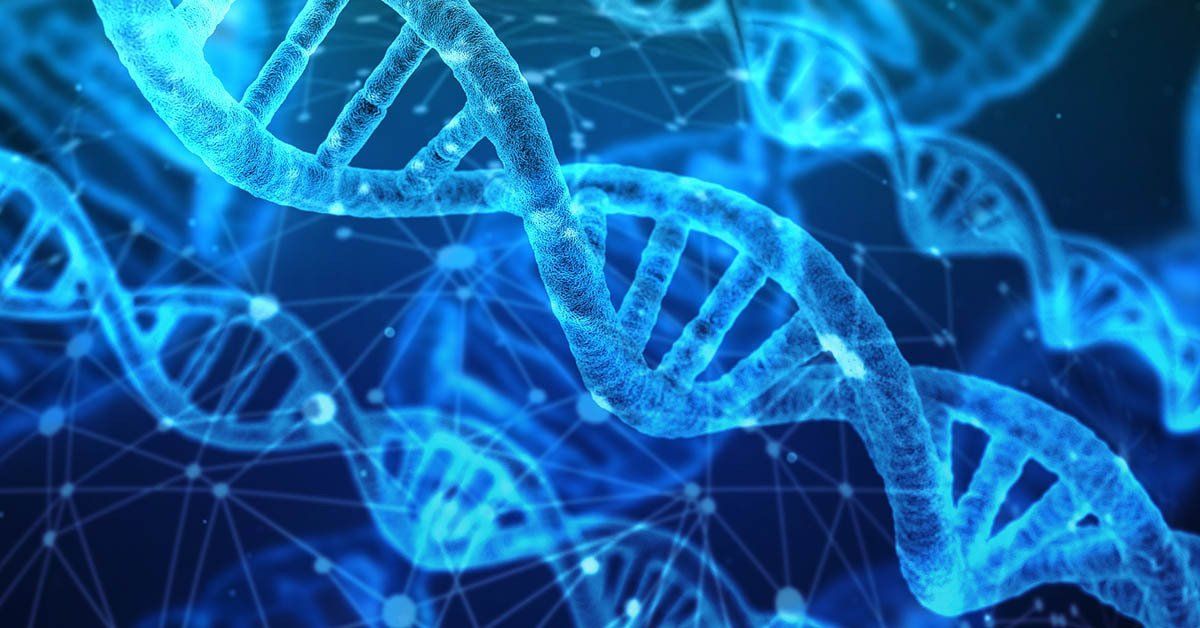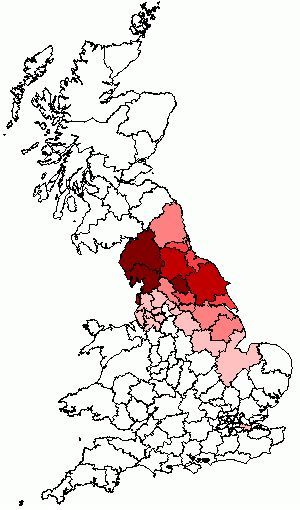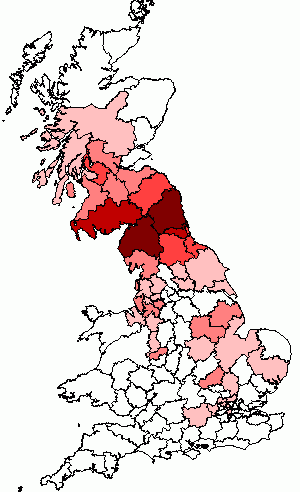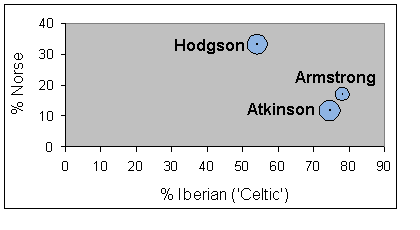Comparative Surname Analysis Gives Us Further Clues About Hodgson History
The Hodgson, Atkinson and Armstrong surnames are all prominent in Cumbria. But comparative DNA analysis confirms that these surnames each evolved in a different way, and represent different clan organisations in the region in earlier times. Two following sections consider the Atkinson and Armstrong surnames in turn. A third section compares their DNA with that of Hodgsons.
Origins and Distribution of the Atkinson Surname
Hodgson and Atkinson Y-DNA turn out to be quite different, despite their occupation of a similar area of England. Their comparison reveals further interesting information about both surnames.
Atkinson is another common surname in the North of England. The 1881 census shows that – like Hodgson – it is most numerous in Cumbria. The map to the left shows the 1881 distribution of the Atkinson surname. (Source:
www.britishsurnames.co.uk.) Compare with the
Hodgson 1881 Map.
In 1881 the Atkinson surname was 1078 per million in Britain, compared with 854 per million for Hodgson and Hodson taken together.
Atkinson means ‘son of Adam’s kin’ (Cottle 1978, p. 42). Could ‘Adam’s kin’ be the name given by the Norse settlers to the original British inhabitants?
The British had been Christian for several centuries when the pagan Vikings arrived. The incomers would have enquired of the British as to their origins. The British would have reported their Biblical belief that they were descended from Adam. The Norse may then have described the British as of ‘Adam’s kin’. The names ‘Atkin’ and ‘Atkinson’ would have then evolved.
Atkinson would thus be an alter ego of the Hodgson surname – signifying British and Christian origins but one formed by, and owing its very existence to, contact with the pagan Scandinavian settlers.
Furthermore, Atkinsons today would be largely descended paternally from indigenous British rather than Norse.1 This is confirmed by DNA evidence. Among the 43 known samples of Atkinson Y-DNA (Atkinson 2008), over 74 per cent are in R1b (corresponding to British and Celtic-speaking areas). This compares with 55 per cent among Hodgsons.
Origins and Distribution of the Armstrong Surname
Armstrong is a border
reiver name, most concentrated in Cumbria and Northumbria. (Source:
www.britishsurnames.co.uk. Compare with the
Hodgson 1881 Map and note the
reiver map on the location of the Armstrong clan.)
In 1881 the Armstrong surname was 846 per million in Britain, compared with 854 per million for Hodgson and Hodson taken together.
According to legend, in an ancient and undated battle the King of the Scots was unhorsed. His armour-bearer picked up the king with one arm and sat him upon his own horse. The grateful king decreed that the armour-bearer's family should thereafter be know as Armstrong, and gave him land along the Scottish Border. The earliest record of the name is in the thirteenth century. (Source: originally from
www.armstrong.org though the specific page is now unavailable and I would welcome further references.)
Hodgson and Armstrong Y-DNA are also different, despite their occupation of a similar area of England. Among the 41 known samples of Armstrong Y-DNA (http://freepages.genealogy.rootsweb.ancestry.com/~gallgaedhil/haplo_armstrongs.htm - consulted March 2008. The web page is now unavailable and I would welcome further references) about 78 per cent are in R1b (DNA prominent in British-Celtic areas). This compares with 55 per cent among Hodgsons.
Furthermore, compared with Hodgsons there is less genetic diversity among Armstrongs. 49 per cent of Armstrongs are in or close to the single modal R1b haplotype. It is possible that most Armstrongs are descended from the original clan leader and founder. By contrast, the explanations given here of the origins of the
Hodgson and Atkinson surnames mean that there was no principal descent from a single medieval paternal ancestor.
Hodgson, Atkinson and Armstrong Y-DNA Compared
Hodgsons have significantly more Norse, and less indigenous British Y-DNA than Atkinsons and Armstrongs, even though they come from the same area of Britain.
1. While most Atkinsons are likely to be of British-Celtic paternal descent, some may be descended from Anglians from Northumbria. However, Oppenheimer's (2006) Y-DNA evidence suggests that the number of Angles and Saxons invading England from the fifth to the seventh centuries was very low - resulting in as little as 5 per cent of the overall population. Their presence was certainly less significant in Cumbria, on the remote, relatively inaccessible and late-conquered western edge of the Northumbrian kingdom.
2. Recent DNA research (Oppenheimer 2006, Sykes 2006) confirms that the majority of males in Britain (denoted by haplogroup R1b) came from Iberia and settled in the British Isles much earlier than the Celts.
3. The degree of Norse Y-DNA in the sample was gauged by the percentage of value 11 at marker DYS 392. The degree of Iberian ('Celtic') Y-DNA was estimated by the percentage of haplogroup R1b in the sample. Both measures are highly approximate. Genetic diversity was calculated over 6 DYS markers using Simpson's Diversity Index.
Atkinson, Christopher (2008)
http://homepage.ntlworld.com/christopher.atkinson700/docs/AtkinsonResults.htm. Consulted March 2008 - web page now archived.
Bugge Alexander (1921) ‘The Norse Settlements in the British Islands’, Transactions of the Royal Historical Society, 4th Series, Vol. 4, pp. 173-210.
Cottle, Basil (1978) The Penguin Dictionary of Surnames (Harmondsworth: Penguin).
Fraser, George MacDonald (1971) The Steel Bonnets: The Story of the Anglo-Scottish Reivers (London: Barrie and Jenkins).
Oppenheimer, Stephen (2006) Origins of the British (London: Robinson).
Sykes, Brian (2006) Blood of the Isles: Exploring the Genetic Roots of Our Tribal History (London: Bantam).



